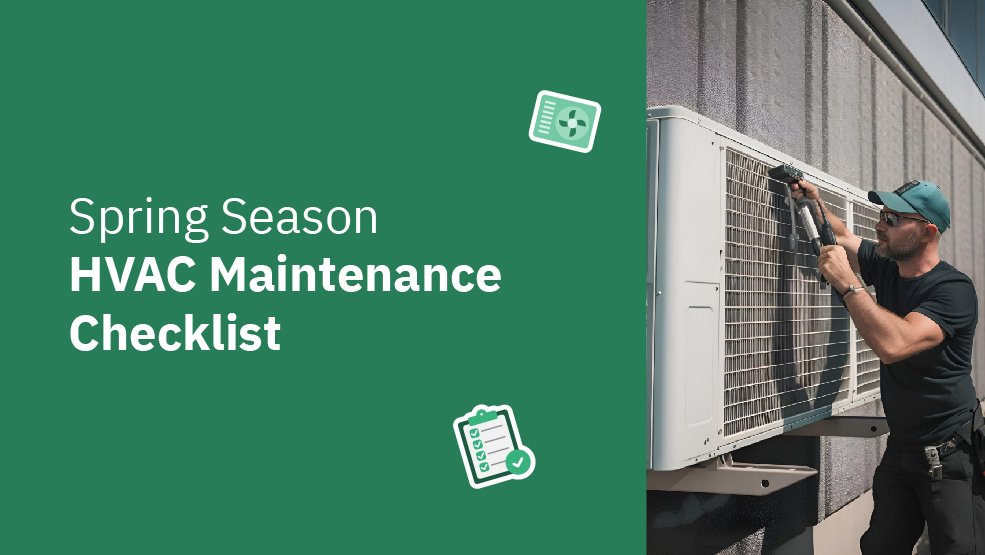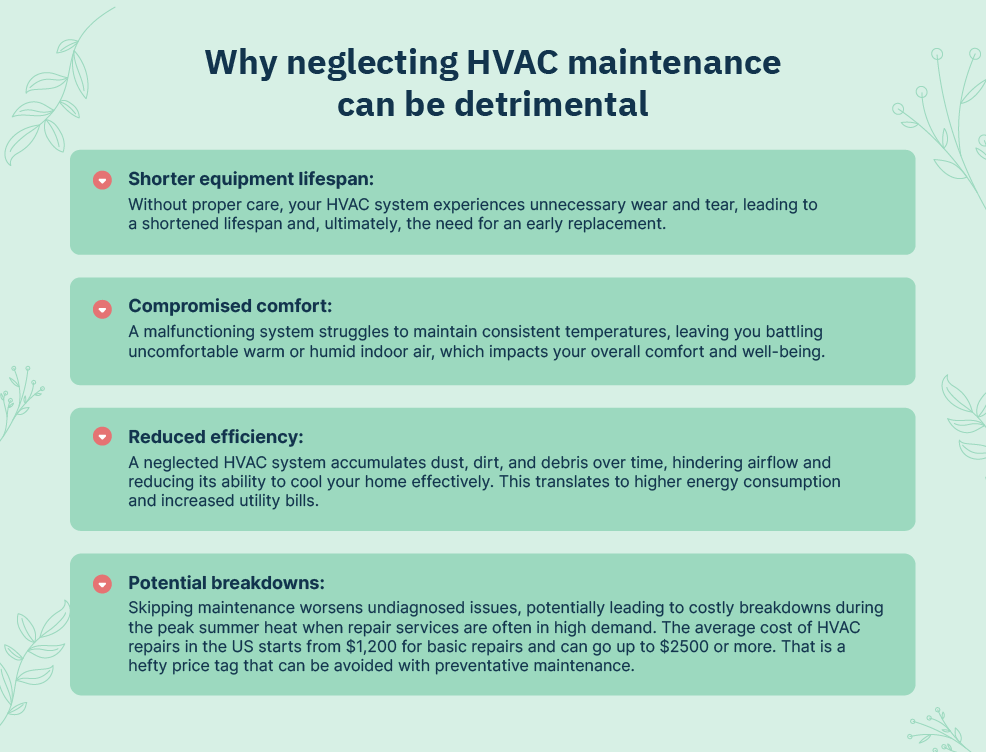Every year in the United States, a staggering three million heating and cooling systems are replaced, and over $14 billion is spent on repairs and maintenance for existing systems. This hefty price tag highlights HVAC’s crucial role in our daily lives. Interestingly, heating and cooling accounts for roughly half of the typical home’s energy usage. This statistic emphasizes the significance of high-performing HVAC systems. Not only do they improve comfort and efficiency within individual homes, but they also contribute to national energy management, reducing overall energy consumption and associated costs.
Imagine waking up on a warm spring morning, eager to throw open your windows and take in the fresh air. But as you reach for the thermostat, a wave of stale, warm air greets you. Your once trusty HVAC system seems sluggish, struggling to keep pace with the changing season. We hope this scenario never happens to you. Unfortunately, this occurrence isn’t uncommon for homeowners who neglect spring maintenance. Like your car, which needs regular tune-ups, your HVAC system requires seasonal attention to ensure optimal performance for energy efficiency and, ultimately, prevent costly breakdowns.
So, what is HVAC?
HVAC stands for Heating, Ventilation, and Air Conditioning. This all-encompassing system plays a crucial role in maintaining comfortable indoor temperatures throughout the year. The core components of HVAC include:
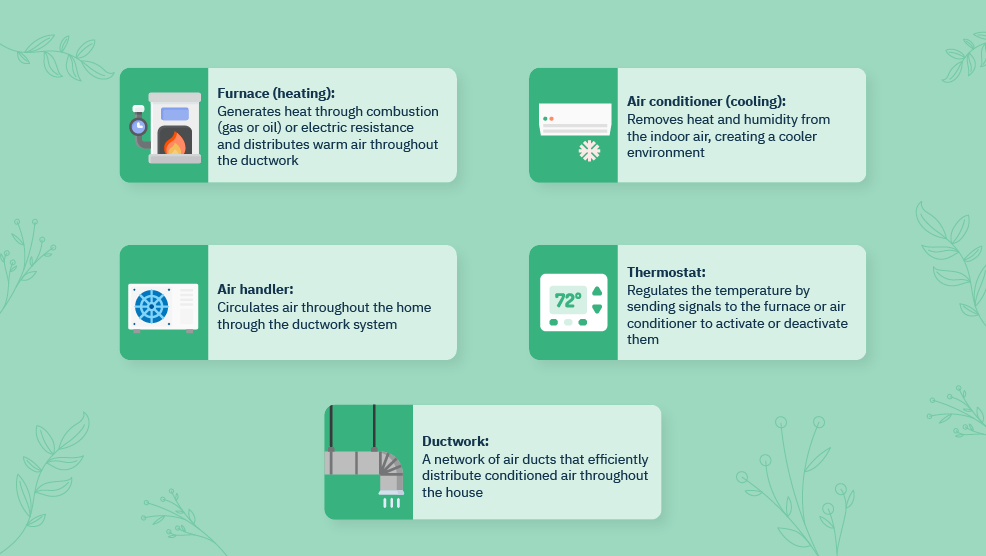
Why spring maintenance?
As winter fades and spring arrives, temperatures rise, demanding a shift from heating to cooling. During this transition, your HVAC system undergoes significant adjustments and changes. Spring maintenance prepares your system for this change, ensuring it operates smoothly and efficiently throughout the warmer months.
Investing in HVAC maintenance during the spring season is a wise decision, not just for immediate comfort and cost savings but also for your HVAC system’s long-term health and efficiency. It’s a small investment that ensures a cool and comfortable home throughout the summer months and extends the life of your valuable equipment.
Spring season HVAC maintenance do-it-yourself (DIY) maintenance vs professional maintenance
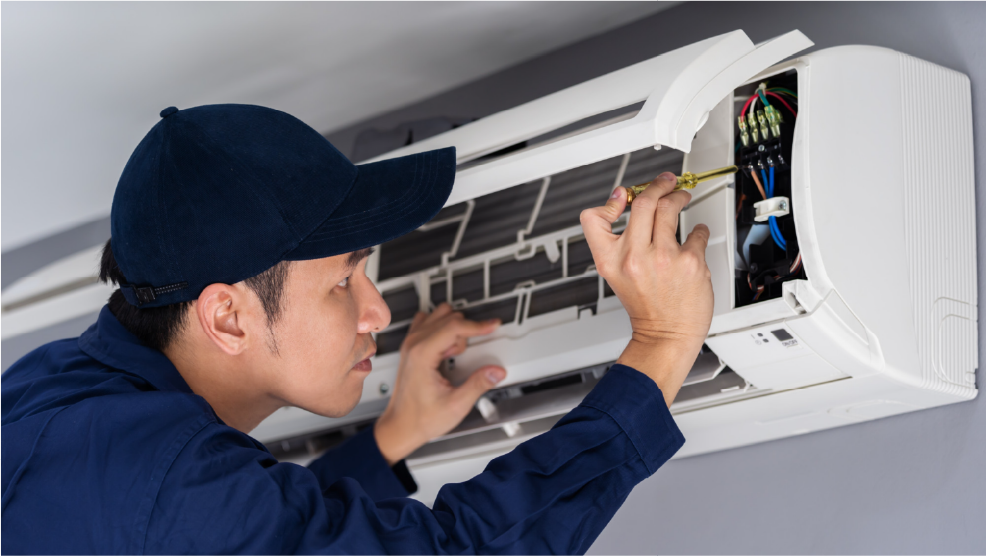
Spring is a crucial time for US households, especially in terms of HVAC maintenance. You must consider two paths to ensure your system is ready for the summer heat. First, there are DIY tasks you can tackle yourself to boost your system’s performance. Secondly, you can take the professional route. Professional maintenance offers comprehensive inspection and cleaning, catching potential problems early and ensuring optimal efficiency.
Spring into action with DIY HVAC maintenance
As spring unfolds and temperatures rise, your once-dormant HVAC system awakens from its winter slumber. Consider tackling some basic maintenance yourself to ensure your system is prepared to tackle the summer heat efficiently. While professional cleaning and inspections are highly recommended, performing DIY maintenance can significantly boost your system’s performance and prepare you for peak demand.
1. Air filter replacement
Your air filter acts as the first line of defense, capturing dust, pollen, and other airborne contaminants before they enter your home’s air circulation. Regularly replacing the air filter is crucial for maintaining optimal airflow and system efficiency.
The types of air filters:
- Fiberglass: The most common and affordable filter, but it needs frequent replacement (every 1-3 months).
- Pleated: These filters are more efficient than fiberglass, capturing smaller particles (replace every 2-3 months).
- HEPA (High-efficiency Particulate Air): Captures the tiniest particles and is ideal for people with allergies (replace every 6-12 months).
Replacement instructions:
- Locate your air filter (usually near the furnace or air handler).
- Note the filter size and type before purchasing a replacement.
- Slide out the old filter and discard it.
- Insert the new filter with the airflow arrows pointing in the correct direction (usually indicated on the filter frame).
2. Thermostat calibration
An accurate thermostat ensures your system operates efficiently and maintains your desired temperature. Over time, thermostats can become slightly miscalibrated, leading to inconsistent temperatures and increased energy consumption.
Importance of calibration:
- Ensures accurate temperature control
- Optimizes system performance and energy efficiency
- Improves comfort and reduces frustration
Calibration instructions:
Most thermostats offer a “calibration” mode, typically accessed through their menu settings. Consult your thermostat’s user manual for specific instructions, but the general steps involve:
- Accessing the calibration mode.
- Comparing your thermostat’s reading to a reliable thermometer in the same room.
- Adjust the thermostat’s reading to match the thermometer’s reading if necessary.
3. Ductwork inspection and cleaning
Ductwork, the network of air ducts that distribute conditioned air throughout your home, can accumulate dust, debris, and mold over time. This can restrict airflow, reduce system efficiency, and impact indoor air quality.
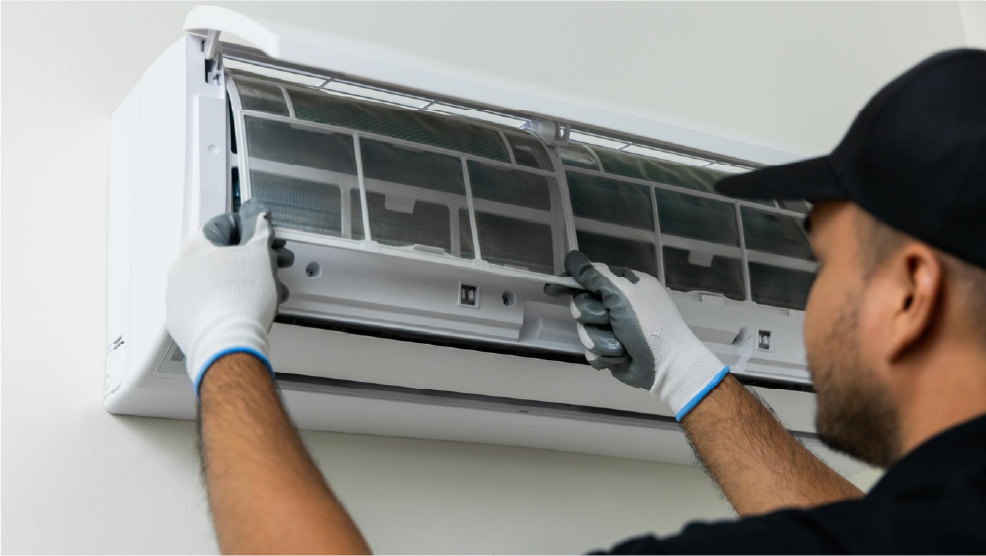
Signs of dirty ducts:
- Increased dust levels in your home
- Uneven temperatures in different rooms
- Visible dust or debris around duct openings
- Rising energy bills
Basic inspection tips:
- Visually inspect the accessible sections of your ductwork for dust build-up or damage.
- Check for any leaks or loose connections around duct joints.
- While basic inspection can provide a general understanding, professional cleaning is crucial for thoroughly removing deep-seated dirt, debris, and allergens from the entire duct system.
4. Condenser unit maintenance
The condenser unit, typically located outside your home, is the heart of your air conditioning system as it releases the heat from the indoor air.
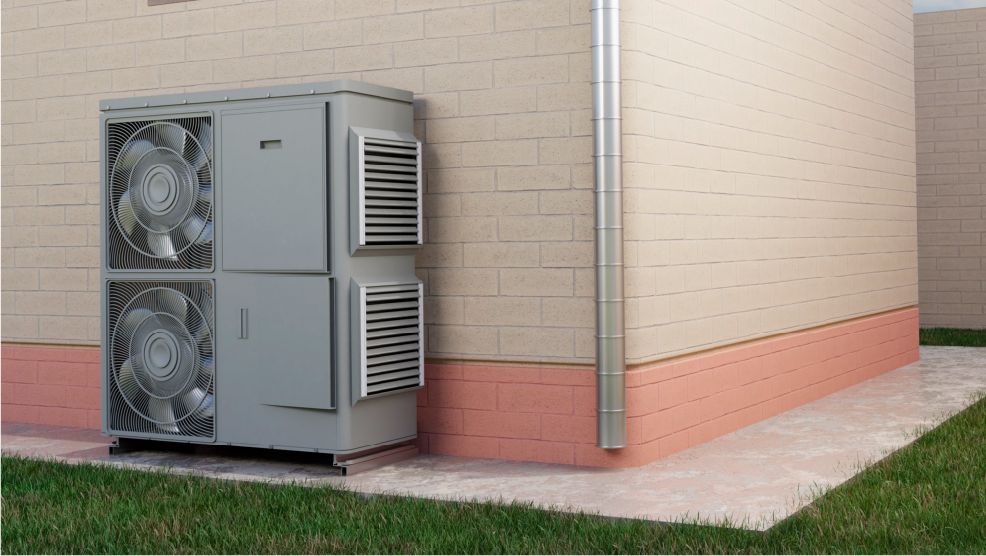
Maintaining the condenser unit:
- Locate the condenser unit near your home’s foundation, usually outside.
- Clear away any leaves, branches, or debris obstructing airflow around the unit.
- Avoid using water directly on the unit, as it can damage electrical components.
5. Lubricate moving parts (if applicable)
Some HVAC systems, particularly older models, may have specific moving parts that require periodic lubrication. It would be a good idea to consult your manufacturer’s manual to determine if any lubrication is necessary or for any other specific instructions on the type of lubricant to use.
While these DIY tasks may seem relatively simple, always prioritize safety and consult your manufacturer’s manual for specific instructions and recommendations for your system since every HVAC unit is different. If you’re not comfortable performing any of these tasks, don’t hesitate to seek assistance from a qualified HVAC professional.
By combining these DIY maintenance steps with professional inspections and cleaning, you can ensure your HVAC system operates efficiently, keeping your home comfortable throughout the summer and avoiding costly breakdowns.
Performance and peace of mind: Professional HVAC maintenance for spring
While DIY maintenance tasks can provide a good starting point, entrusting your HVAC system to a qualified professional for spring maintenance is crucial for ensuring optimal performance, preventing costly breakdowns, and extending its lifespan. Here’s how professional maintenance goes beyond the basics:
1. System inspection
A comprehensive professional inspection is akin to a thorough medical checkup for your HVAC system. It involves inspecting various components, including the furnace, air conditioner, ductwork, and electrical connections. This meticulous examination allows technicians to:
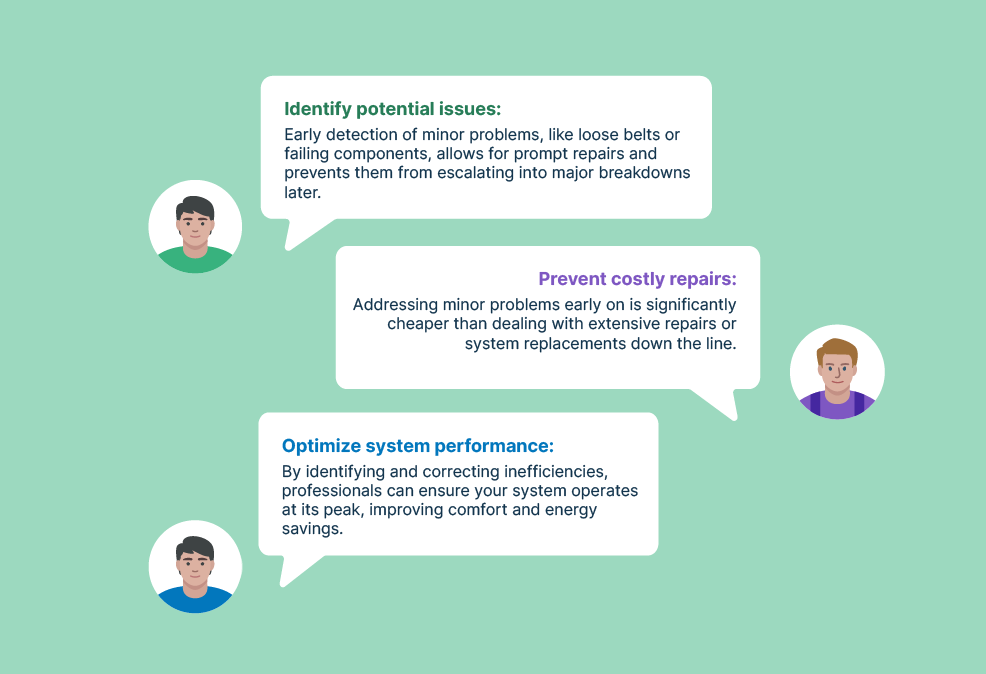
2. Coil inspection and cleaning
Both the evaporator coil (located indoors) and condenser coil (located outdoors) play a crucial role in heat transfer. Dust, dirt, and grime buildup on these coils can significantly hinder their ability to absorb and release heat, leading to decreased system efficiency and increased energy consumption.
Importance of professional cleaning:
- Specialized techniques: Professionals use specialized tools and cleaning solutions to remove stubborn dirt and debris from the delicate coils safely, maximizing heat transfer and system efficiency.
- Improved air quality: Clean coils not only enhance system performance but also improve indoor air quality by preventing dust and allergens from circulating throughout your home.
3. Refrigerant levels
Refrigerant is the lifeblood of your air conditioning system, absorbing heat indoors and releasing it outdoors. Improper refrigerant levels can have several detrimental effects:
Low refrigerant levels: Reduce cooling capacity, leading to poor performance and increased energy consumption.
Overcharged refrigerant: System damage, potential compressor failure, and safety hazards.
Why professional handling is crucial:
- Refrigerant is a regulated substance: Adding or removing refrigerant requires specialized training and certification to ensure safety and compliance with environmental regulations.
- Leak detection and repair: Trained professionals can identify and repair leaks, preventing refrigerant loss and ensuring optimal system operation.
4. Electrical connections
Electrical connections are vital for your HVAC system’s safe and efficient operation. Loose, damaged, or corroded connections can lead to:
Reduced system efficiency: Improper connections can hinder power flow, forcing your system to work harder, ultimately consuming more energy.
Electrical hazards: Faulty connections pose potential fire risks.
Importance of professional inspection:
- Trained eyes for potential hazards: Professionals can meticulously inspect all electrical components, identifying loose connections, damaged wires, or potential fire hazards.
- Ensuring safety and peace of mind: A thorough electrical inspection provides peace of mind, knowing your system operates safely and efficiently.
5. Blower components
The blower fan is responsible for circulating air throughout your duct system. Over time, the blower components can accumulate dust, dirt, and wear and tear, leading to:
Reduced airflow: Clogged blowers disrupt airflow, hindering your system’s ability to distribute conditioned air throughout your home effectively.
Increased noise: Worn-out blower components can generate excessive noise, impacting comfort and creating an unpleasant environment.
Professional cleaning and maintenance:
- Thorough cleaning: Professionals use specialized techniques to clean and lubricate blower components, ensuring optimal airflow and reducing noise levels.
- Extends lifespan: Proper maintenance helps prevent blower components from wearing down prematurely, extending the overall lifespan of your system.
Investing in professional spring HVAC maintenance is not just an additional expense; it’s a wise investment that safeguards your HVAC system. It ensures peak performance, reduces energy consumption, and ultimately saves you money in the long run. By combining DIY maintenance tasks with professional expertise, you can ensure your HVAC system operates efficiently. This will help you keep your home comfortable throughout the hot summer months, providing peace of mind knowing it’s properly maintained and safe to use.
The benefits of spring HVAC maintenance
Just as your car needs regular tune-ups to keep running smoothly, your HVAC system also benefits from proper spring maintenance. This seemingly small step offers a multitude of benefits that extend far beyond simply ensuring you enjoy cool air during summer. Let’s look at the benefits of embracing HVAC maintenance during the spring season and how it can positively impact your home environment, wallet, and health.
1. Improved system efficiency
Over time, dust, dirt, and debris can accumulate within your HVAC system, hindering its ability to operate smoothly. This internal resistance forces the system to work harder to maintain desired temperatures, increasing energy consumption. Spring maintenance addresses these issues through cleaning and inspections and optimizes the HVAC system’s performance. Clean components experience less friction, allowing the system to function efficiently, translating directly to lower utility bills. Imagine enjoying comfortable temperatures without worrying about skyrocketing energy costs, thanks to a well-maintained HVAC system.
2. Enhanced comfort
A neglected HVAC system struggles to maintain consistent temperatures, leaving you battling discomfort and frustration. Spring maintenance ensures your system operates optimally, guaranteeing that your home remains cool and comfortable throughout the summer months. Consistent and reliable temperature control allows you to create a relaxing and enjoyable environment free from the stress of fluctuating temperatures.
3. Extended system lifespan
Your HVAC system is a valuable investment. Like any other investment, regular maintenance is crucial to ensure longevity. By neglecting spring maintenance, you essentially ignore potential problems lurking within your system. These seemingly minor issues, if left unchecked, can escalate into major breakdowns, ultimately leading to premature system replacement. On the other hand, investing in HVAC spring maintenance is like taking preventative measures. Professionals can identify and address potential issues early on, preventing them from snowballing into costly repairs.
4. Reduced repair costs
Proactive maintenance is always preferable to reactive repairs. Spring maintenance allows professionals to identify potential issues early on when they are often easier and significantly cheaper to address. Early detection and resolution of minor problems prevent them from escalating into major breakdowns requiring extensive repairs or system replacements. This proactive approach translates to significant cost savings in the long run. Consider spring maintenance as an investment in preventing costly surprises down the road, ensuring your peace of mind, and avoiding the financial burden of unforeseen repairs.
5. Improved air quality
Your HVAC system plays a crucial role in maintaining the temperature and air quality within your living space. Air filters act as the first line of defense, capturing dust, allergens, and other airborne contaminants. Over time, clogged filters become less effective, allowing these harmful particles to circulate throughout your home, impacting your health and well-being. Spring maintenance, emphasizing cleaning air filters and ducts, ensures your system effectively removes these contaminants, leading to cleaner and healthier indoor air. This is especially beneficial for individuals with allergies or respiratory problems, allowing them to breathe easier and experience improved overall health.
Embracing spring HVAC maintenance is a win-win proposition. The benefits are undeniable, from improved efficiency and comfort to extended lifespan and cost savings. Additionally, maintaining your system ensures cleaner indoor air, contributing to your overall health and well-being. Spring provides the perfect opportunity to give your HVAC system the attention it deserves, ensuring a summer filled with comfort, peace of mind, and, potentially, lower utility bills.
Embracing year-round comfort: Prevention is cheaper than repair
While spring is the ideal time for comprehensive HVAC maintenance, remember that your system deserves attention throughout the year. Scheduling maintenance before the cooling and heating seasons ensures peak performance and optimal comfort regardless of the outside temperature. Establishing a regular maintenance schedule, at least—once a year professionally—is key to preventing problems, extending your system’s lifespan, and saving money in the long run.
Programmable thermostats offer an excellent way to optimize energy usage further and maintain comfortable temperatures. Automatically adjusting temperatures based on pre-set schedules can significantly reduce energy consumption while ensuring your home is cool when needed.
It is also important to acknowledge that DIY maintenance has its limitations. While basic tasks like filter replacement are manageable for most homeowners, tackling complex repairs or intricate cleaning procedures is best left to the professionals. They possess the expertise, tools, and experience to diagnose and safely address any issues your system may encounter.
In conclusion, maintaining your HVAC system is not just about surviving the occasional heat wave; it’s about creating a comfortable and healthy living environment all year round, optimizing energy efficiency, and ensuring your investment lasts for years. Make spring HVAC maintenance a regular part of your home routine, and consider seeking professional assistance for a comprehensive inspection and cleaning. Don’t wait until the discomfort sets in—take action today and schedule your spring maintenance appointment to breathe easy all year long. To learn more about HVAC maintenance, click here. If you would like us to show you how you can implement checklists and organize your HVAC business better, why not sign up for Zuper’s free demo?
